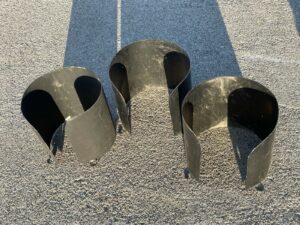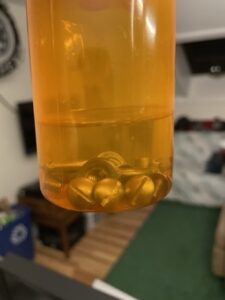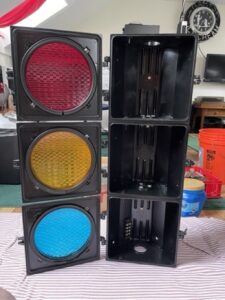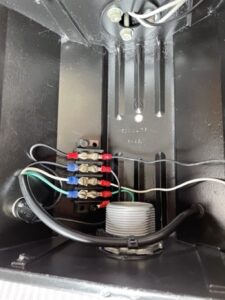
1957 Econolite “Long Groove” Traffic Signal:
Econolite actually dates back to 1933 but they were primarily sellers and installers of GE signals until 1957 when Econolite bought out the GE line and created this “Long Groove” model. This design had 3 “Long Grooves” from top to bottom of each section which was similar to GE’s previous design including two grooves, broken only by the oval Econolite logo where the round GE logo would have been. In late 1959 to early 1960, the design was changed to address a moisture issue the long grooves introduced. Making a signal head that I had found even more cool than it was when I thought it was circa late 70’s early 80’s. It’s impossible to get an exact date of production on most traffic signals, so being able to narrow it down to a definite 3 year period to me is amazing. So what made me bring this old guy home if I didn’t know what it actually was?
When I was a kid I realized that I had a real affinity for traffic signals of all kinds. I remember praying for a train to cross when my mother would take us to our grandparent’s house so I could watch the gates come down and go up or, miss a walk signal cause I was watching the opposing traffic signal change. I got to watch a signal being serviced and even was allowed to connect a meter in a median flasher turning it on when on my way to my grandmother’s house. I have no idea how this fascination began but I can tell you that of all signals, I always wanted my own traffic light. This year all I know is I finally found one that needed work and wasn’t too expensive so I bought it, knowing absolutely nothing about its age or history; replaced its missing visors, polished up its lenses, replaced the failing wiring and fixtures, and painted it inside and out. What it all looked like when I purchased it:




Then I got right to work stripping it out and making a list of things I was going to need to get it back into operational shape. I love the color red but chose to dress it up in all satin black. Which meant I really needed to get all that red paint off of the hardware on the outside and address quite a bit of corrosion inside. This involved lots of sanding, scrubbing, and chemical stripping. Once I had the cleanup and repairs out of the way, each section was primed with self etching gray, sanded, and sprayed again.




Then out to the backyard I went to give it its final paint job: multiple layers of Krylon Satin Black. I had originally planned to do the body of the signal “Traffic” yellow and the doors and visors a flat black until I saw another that was 100% gloss black. I liked the look but decided gloss black would look too refinished. So I went with Satin Black and could not be happier. Then the next day I reassembled it and got the sections re-attached.




Then it was time to install the freshly painted visors, install the new reflectors, set up the new electrical components, and a really cool programmable sequencer from Galak Electronics. Programming it was easy and was really cool to test out even before the signal was done.




Then it was time to make sure it all worked. I purposely pretested everything with a multimeter so I could get a video of the very first time this old signal would run through an actual traffic pattern once again. The video below is the absolute first time it had power applied after being completely assembled.
